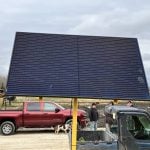On Feb. 16 we celebrated Ian’s third birthday. We had supper and cake and ice cream with Grandpa John and Grandma Barb. He enjoyed having his own party this year.
On the 17th our Jersey milk cow freshened. It was still very cold and she surprised us. We weren’t expecting her to calve for a week or so. Thankfully she had it in the heavily-bedded shed. He lost the tips of his ears but otherwise, he was a healthy calf and we got them moved into the barn as soon as we found him.
On the 18th we celebrated James’ fifth birthday. The kids had a bit of a cough and runny noses so we had a quiet supper with John and Barb. James asked for a yellow cake with green icing this year to remind him of spring and the seeding tractors.

On the 21st we had our first beef calf. It had warmed up quite a bit. After that, we had one or two calves every day and they were all healthy and the weather was very co-operative.
Read Also

Gentle treatments for pain in the neck
Heading toward year-end, people unknowingly tense up against the cold and busyness, causing neck pain that can often be treated with appropriate support and gentle mobility, athletic therapist Kathlyn Hossack says.
On the 24th we had a belated birthday supper for James and Ian with our neighbours and friends, the Sutherlands. The kids had fun playing outside and seeing all the new baby calves.
March came in like a lamb and we continued to enjoy the nice weather, as did all the baby calves. On the 8th we had an emotional day. Gregory found a four-day-old calf that was slightly bloated, weak and lethargic. We couldn’t quite figure out what was wrong but we got some fluids in him, gave him a shot of penicillin, and rubbed some DMSO on him. Within a short time, he died. It is always hard to lose animals, especially when you aren’t sure what happened.
Then a few hours later, Gregory found another calf in distress. He was very weak and wobbly and kicking violently at his slightly bloated stomach. I quickly called the vet because we had something going on that needed to be figured out. Before the vet arrived, the second calf died. The vet did a necropsy and it wasn’t what he was expecting. One calf died of an E. coli infection and the second was a clostridial bacteria.
Due to the great number of strains of each, vaccines are not always effective in cases such as these. The vet did leave us with an injectable antibiotic to try immediately if we noticed a calf that was a little off, slow or slightly bloated.
READ MORE: Tips on managing clostridial diseases in cattle
Good vets are hard to come by sometimes and it is especially hard to get someone to come out on a Saturday, but we are grateful that Dr. Colton of Eagle Creek Vet took the time to help us out. Later that same evening we found another calf that was slightly bloated and slow. We gave him a dose of the antibiotic and within four hours he was greatly improved, and by the next day, he was trying to bounce and play in the sunshine.

While we worked with the sick calves, we were also preparing for another birthday party. That evening we had John and Barb over for Barb’s 74th birthday. It turned out to be a very nice evening, and the cherry on top was when the antibiotic seemed to be working and the calf was improving.
After that, we kept an eagle eye on our calves but we saw no more sick ones. I’m not sure what caused the calves to be ill. We are suspicious that it was something in a bale, maybe a contaminated animal or something. It may be something we never will figure out, but we are very grateful it did not go through the whole herd.
Despite our hardship with the sick calves, we have been blessed with a wonderful calving season. On average, our calves were quite a bit bigger this year.

Thanks to our easy-calving bulls, the cows and heifers had no problems, and we haven’t had to pull or even help any of them yet. The drastic changes in the weather this winter did affect the growth of the calves. When the cows ate more to keep warm as the weather drastically dropped, the developing calves got more too.
We were quite excited because by the end of the first breeding cycle, we were over two-thirds calved out. The last few always seem to take their sweet time but soon we will be calved out and then will turn our attention to the foaling mares.
















